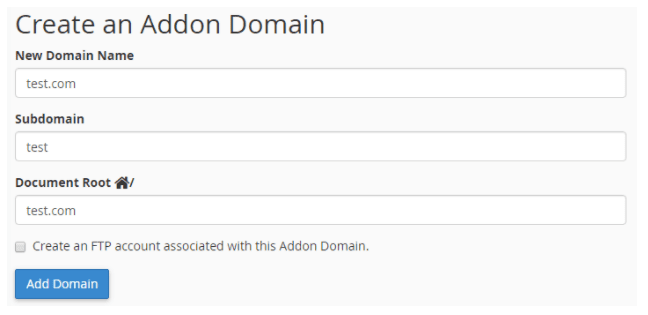Bloggers are always looking for ways to make their websites look more professional. One way of doing this is by adding an addon domain in cPanel.
This will allow you to have a subdomain that directs to another site, which is very useful if you want your visitors to be able to access your other sites without typing in the full URL address. We’ll show you how!
Adding an addon domain in cPanel is a pretty straightforward process. In this tutorial, I will be showing you how to do just that. All of your domains are listed on the left-hand side under “Domains” and you have the ability to add more by going to “Addon Domains” which can be found right underneath it.
There should already be a default domain added if not, go ahead and click on “Add Domain” and fill out all of the details for your new addon domain!
Informative tone with steps to complete task above written as “add an addon domain” using creative sentence structure that keeps reader engaged from start to end.
There are several reasons why you may want to add an addon domain in cPanel. For example, if you have more than one website and can’t afford hosting for each of them separately, then this is a great option to consider.
Other common scenarios include using different nameservers or subdomains of the main domain name. You will need to follow these steps:
1) Login into your cPanel account;
2) Click on “Addon Domains” under the “Domains section”;

3) Enter the desired new hostname that will be added as an addon domain in next field (make sure it doesn’t exist yet);
4) If you wish, enter.
Table of Contents
What is an Addon Domain?
For You Information, An addon domain also known as a secondary domain or subdomain is the second level of your main website. It’s an additional part of your site that you can use for more URLs on your site. Addon domains are often used to create another place for users to go, or to point different parts of your site to different servers.
For example, if your website is www.domainA.com then the add-on domain may be something like blog.domainA.com or wiki.domainA.com .
Addon Domains are essentially like sub-directories of your main website (e.g.: domainA). Unlike sub-domains, addon domains have exactly the same privileges as your main website. For this reason, you should only use them when you want to host different content on each domain URL.
What is Cpanel?
A web hosting control panel is a management system for a remote server, which helps the web hosting provider to manage their client’s websites by providing necessary tools and controlling what they can do or cannot on those sites. The most common control panels are Plesk, Cpanel, DirectAdmin and InterWorx.

Cpanel is a web hosting control panel developed by CPanel, Inc. It runs on Linux and UNIX servers. The current version of cPanel & WHM supports the latest versions of CentOS 5 or Red Hat Enterprise Linux 5 distributions.
cPanel provides a graphical interface to perform most necessary administration tasks, such as creating and removing user accounts, adding and editing domains, running batch processes such as account transfers and DNS changes, etc. It also supports a number of add-on applications to provide additional functionality.
Cpanel is open source software licensed under the GNU General Public License with exceptions for cPanel Services, Inc.’s addons/enhancements; which are provided under separate license agreements as either cPanel-branded or vendor-branded addons/enhancements.
Cpanel is for more advanced users and may require some level of Linux knowledge to configure and control.
Types of Domain-
Sometimes, I come across things on the Internet that seems to have originated from a parallel universe.
But let’s start with explaining what an addon domain is, just in case you’re not that familiar with the term. An addon domain (also sometimes called a secondary domain) is basically an additional website that you can host on your VPS for free – at least on some hosting providers.
You can use it as a development server, a testing server, or just for fun. Addon domains are usually not visible to the public Internet through you can enable this if you want.
Before we go into further detail about addons, I have one quick note: This article is going to be fairly long – so if you don’t have the time to read it all at once, just bookmark it for later.
##The concept of addon domains
Now let’s first have a look at how some companies handle addon domains. In the past, I used some web hosting providers where I could simply add an addon domain by entering the name and pressing a button: No further configuration was necessary and no additional fees were charged.
However, the biggest hosting companies in the world require a little more work to set it up. Now before we go into further detail here, I have to say that having an addon domain is one of the most requested features from our customers and even though it can be quite complicated to set up, we prioritize this feature.
If you don’t have an addon domain yet, just change your hosting plan to one of our higher plans and you’ll be able to create several addon domains.
Let me give you a quick example: Say you have a VPS from us and want to install WordPress on this server so that it can serve as a blog engine. If you have the “Pro” plan (or something like that), you’re able to install WordPress quickly and easily. If you want to create another website for example, this would be an addon domain on your server.
List of the Most Common Domain Extensions-
The Internet has opened the work of business to a much larger audience. No longer do communicators have to rely on finding prospects in the phonebook or through referrals from other buyers. Now, by setting up shop online, even companies with local presence can become worldwide suppliers.
While this is beneficial for companies looking to find new audiences and customers (in addition to suppliers and vendors), it can make things difficult for those who want to use the Internet as a research tool. In addition, some folks may find that they don’t have the time or patience to sort through all of the websites that come up on a search engine page.
To help both groups and individuals who are looking for information online, this article takes a look at some of the most common domain extensions that are used. Domain extensions are terms that come after the “dot” in a website’s address. They are typically two letters long and indicate what type of website is being accessed.
For example, “.com” indicates that it is an American commercial site while “.edu” indicates an American educational site. Many of these extensions are open to any type of user while others may be restricted by law or agreement, such as “.coop,” “info,” and “.mil.”

How does the Addon Domain Work?
In this article I’m going to explain what an addon domain is and when you should use it.
In general words, addon domains are additional TLDs for your website. It will be actually an own site in a separate folder on your main web server with separate content, configuration and so on. You can link/redirect from your main domain or website as you wish.
You might ask “Why do I need that?” In fact it’s a good idea to separate your main site from other projects, web apps and so on which you develop/own/manage over time, but don’t want to put them on the same domain as you main site. For example a lot of WordPress plugins create their own site for their user/client which is actually useless for your main domain.
In conjunction with subdomains it helps a lot to structure and separate your websites (projects) from each other without fear of interfering with the main site connection or important links, search engine accessibility and so on.
So what addon domains can do for you?
Here are some examples:
Create an own project site on it’s own TLD. And host it with your main web service provider. Also you can now use addon domains as subdomains if needed.
Use one of the addon TLDs to separate non-important or temporary pages from your main domain – let’s say you have a blog on your main domain, but sometimes publish guest posts, or something else “not related” to your main website/domain – you can create addon domains with different names and point them as subdomains for that purpose.
Set up additional TLDs pointing to the same content as the main site for search engine visibility reasons.
For example having a site on “mysite.com” and another one on “demosite.com” – you can set up both of them to point to the same web location, but use different TLDs for better indexing results from Google/Bing/Yahoo etc.
Quick Links
- How To Save Money On Web Hosting Renewals For WordPress Blogs
- ThemeFuse Themes Giveaway
- Advantages Of Self-Hosted Blog
Conclusion– How To Add An “Addon Domain” In cPanel 2024
Addon domains are a great way to strengthen your website’s SEO and increase monetization opportunities. If you have an addon domain, make sure it has the same IP address as the main domain.
Doing so will help with any duplicate content issues that may arise later on down the line if not done correctly from the beginning. Adding an addon domain in cPanel is simple enough for most users but can be more complicated for others. It all depends on what level of technical expertise you possess! For those who need some assistance, check out our blog post.
You can add an addon domain in cPanel. Here are the steps to do so!
1) Click on Domains and then click Addon Domain
2) Fill out all of the fields for your desired URL
3) Click Create
4) Check that you have entered everything correctly
5) Review any additional information
6) Click Save
7). Congratulations, you now have an addon domain!





